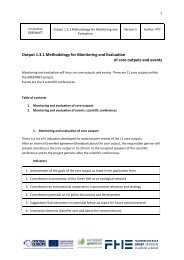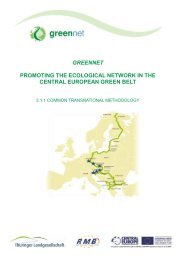The Green Belt as a European Ecological Network strengths and gaps
The Green Belt as a European Ecological Network strengths and gaps
The Green Belt as a European Ecological Network strengths and gaps
You also want an ePaper? Increase the reach of your titles
YUMPU automatically turns print PDFs into web optimized ePapers that Google loves.
Schlumprecht, H., Laube, J.<br />
MONITORING BIODIVERSITY OF THE THURINGIAN GREEN BELT<br />
Table 3: Species richness of gr<strong>as</strong>shoppers, butterflies, <strong>and</strong> birds<br />
Numbers of species according Red List of Thuringia; in brackets (G: ) according Red List of Germany<br />
Number of Red List Number of Red List<br />
gr<strong>as</strong>shopper Gr<strong>as</strong>s- butterfly butterfly Bird Red List<br />
ID L<strong>and</strong> use species hoppers species species species birds<br />
2 No use 11 (G: 1) 43 4 (G:18) 20 2 (G: 5)<br />
9 No use 9 21 2 (G: 5) 22 1 (G: 4)<br />
10<br />
Cattle<br />
grazing 10 33 2 (G:12) 24 0 (G: 2)<br />
12<br />
Cattle<br />
grazing 7 30 2 (G:10) 26 3 (G: 4)<br />
15<br />
Sheep<br />
grazing 15 2 (G: 2) 47 7 (G:24) 33 6 (G: 11)<br />
24<br />
Goat<br />
grazing 9 26 3 (G: 10) 23 3 (G: 4)<br />
30 No use 8 19 1 (G: 4) 25 1 (G: 2)<br />
3 DISCUSSION<br />
3.1 Threatened plant species <strong>and</strong> l<strong>and</strong> use types<br />
At the monitoring sites there is a clear dependence between the l<strong>and</strong> use type <strong>and</strong> the<br />
occurrence of threatened species, see Table 4. Generally, most endangered species occur in<br />
biotopes grazed by cattle or sheep (51 occurrences of threatened species). A high number of<br />
rare species can also be found in biotopes without current use or management (39<br />
occurrences), less species are found in biotopes that are mown or cleared (6 <strong>and</strong> 3<br />
occurrences). <strong>The</strong> high number of endangered species occurring in unused biotopes is<br />
however misleading, <strong>as</strong> missing l<strong>and</strong> use is only favourable to a certain extent of shrub<br />
encroachment. Habitats with higher amounts of shrub cover (level 5 <strong>and</strong> onwards, i.e. 40 %<br />
shrub cover) were mostly not mapped <strong>as</strong> valuable biotopes, <strong>and</strong> threatened species are<br />
seldom. It is hence very likely that rare plant species actually occurring at unused biotopes<br />
disappear in the future if succession to young forests continues.<br />
Table 4:<br />
Number of rare plant species by l<strong>and</strong> use type <strong>and</strong> shrub cover<br />
Degree of shrub cover Grazing No usage Mowing Post clearing Sum<br />
0: 0 or not noteworthy 8 6 3 17<br />
1: up to 10 % 29 6 3 3 41<br />
2: up to 20 % 8 8 16<br />
3: up to 30 % 4 13 17<br />
4: up to 40 % 1 6 7<br />
5: up to 50 %<br />
6: up to 60 % 1 1<br />
7: up to 67 %<br />
Sum 51 39 6 3 99<br />
For 20 out of the total number of 41 rare species the datab<strong>as</strong>e BIOLFLOR [12] lists<br />
grazing <strong>and</strong> mowing tolerances (each from 1: no tolerance to 9: completely tolerant). A value<br />
41




